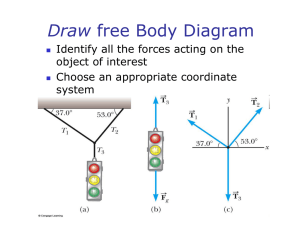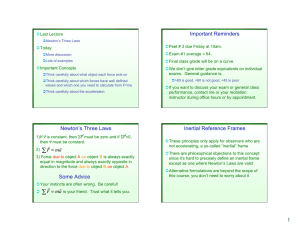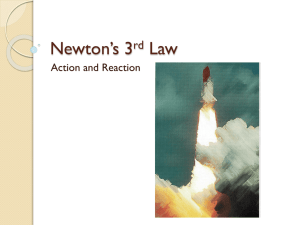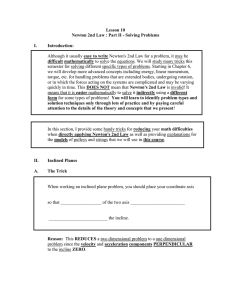Document 10455500
advertisement
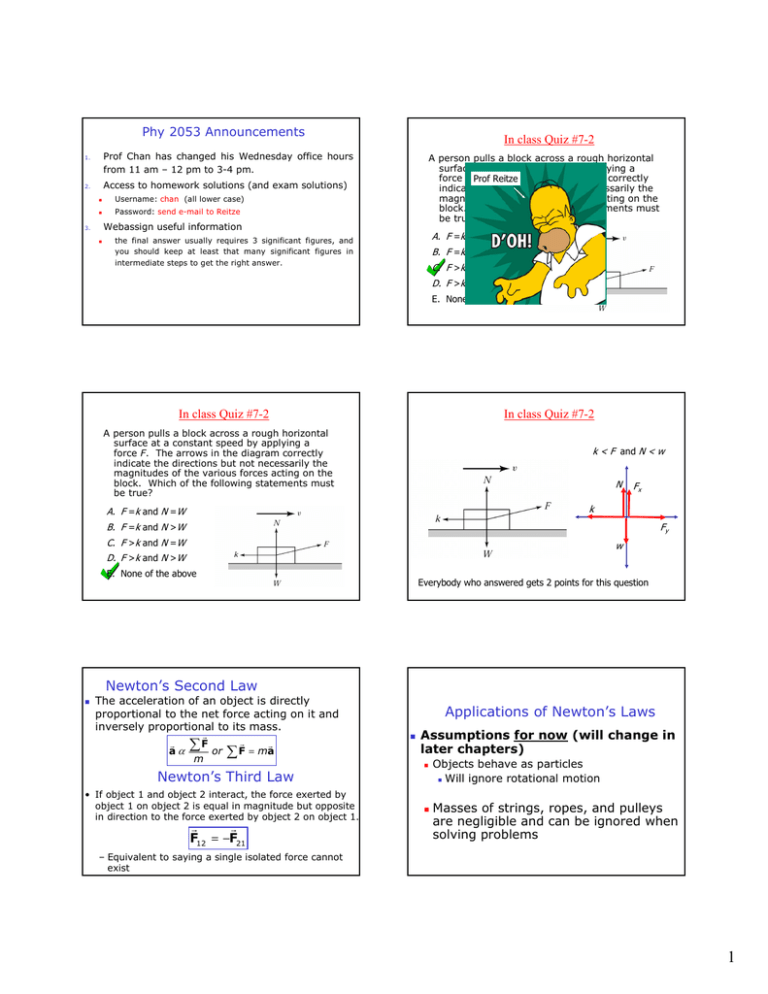
Phy 2053 Announcements In class Quiz #7-2 Prof Chan has changed his Wednesday office hours from 11 am – 12 pm to 3-4 pm. 1. A person pulls a block across a rough horizontal surface at a constant speed by applying a force F.Prof The arrows in the diagram correctly Reitze indicate the directions but not necessarily the magnitudes of the various forces acting on the block. Which of the following statements must be true? Access to homework solutions (and exam solutions) 2. Username: chan (all lower case) Password: send e-mail to Reitze Webassign useful information 3. A. F =k and N =W the final answer usually requires 3 significant figures, and you should keep at least that many significant figures in intermediate steps to get the right answer. B. F =k and N >W C. F >k and N =W D. F >k and N >W E. None of the above In class Quiz #7-2 In class Quiz #7-2 A person pulls a block across a rough horizontal surface at a constant speed by applying a force F. The arrows in the diagram correctly indicate the directions but not necessarily the magnitudes of the various forces acting on the block. Which of the following statements must be true? k < F and N < w N Fx k A. F =k and N =W B. F =k and N >W Fy C. F >k and N =W w D. F >k and N >W E. None of the above Everybody who answered gets 2 points for this question Newton’s Second Law The acceleration of an object is directly proportional to the net force acting on it and inversely proportional to its mass. r aα r ∑ F or m r r ∑ F = ma Newton’s Third Law • If object 1 and object 2 interact, the force exerted by object 1 on object 2 is equal in magnitude but opposite in direction to the force exerted by object 2 on object 1. r r F12 = −F21 Applications of Newton’s Laws Assumptions for now (will change in later chapters) Objects behave as particles Will ignore rotational motion Masses of strings, ropes, and pulleys are negligible and can be ignored when solving problems – Equivalent to saying a single isolated force cannot exist 1 Free Body Diagram Example #4.21 1. Two blocks each of mass 3.5 kg are fastened to the top of an elevator. (a) If the elevator accelerates upward at 1.6 m/s2, find the tensions T1 and T2 in the upper and lower strings. (b) If the strings can withstand a maximum tension of 85 N, what maximum acceleration can the elevator have before the first string breaks? 2. 3. 4. ∑F x Choose the coordinate system with x in the same y or opposite N x direction of T acceleration and y a perpendicular to x. θ Replace the force sin osθ of gravity with its mg θ gc m θ components. mg θ A van accelerates down a hill (Fig. P4.71), going from rest to 30.0 m/s in 6.00 s. During the acceleration, a toy (m = 0.100 kg) hangs by a string from the van’s ceiling. The acceleration is such that the string remains perpendicular to the ceiling. Determine (a) the angle θ and (b) the tension in the string. ∑F y =0 y x T mg cosθ - mg cosθ mg sinθ -mg sinθ 1. 2. 3. 4. Example #4-73 = 0 and What force is acting on the mass along the inclined plane (in the +x-direction)? Inclined Planes Identify all forces acting on object Choose coordinate system Resolve forces into components along the coordinate axes Use Newton’s laws to solve for unknown mg Two objects connected by a massless string Draw free body diagrams Apply Newton’s Laws separately to each object The magnitude of the acceleration of both objects will be the same The tension is the same in each diagram Solve the simultaneous equations 2 Example #4-38 Two objects with masses of 3.00 kg and 5.00 kg are connected by a light string that passes over a frictionless pulley, as in Figure P4.34. Determine (a) the tension in the string, (b) the acceleration of each object, and (c) the distance each object will move in the first second of motion if both objects start from rest. 3

